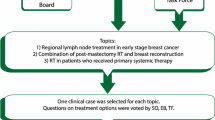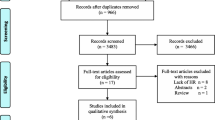Abstract
The international conference of adjuvant therapy for primary breast cancer in St. Gallen and the National Institute of Health Consensus Conference for Breast Cancer Treatment have recommended appropriate treatment for individual subgroups by recurrence risk. However, evidence provided by Japanese clinical trials did not contribute to the consensus recommendations. To compare the risk of recurrence in breast cancer patients between Japan and western countries, a database of Japanese breast cancer patients was analyzed. From 1991 to 2001, approximately 12,100 articles listed on MEDLINE were reviewed by abstract, and articles were then selected and reviewed by the authors. According to the AHPC (Agency for Health Care Policy and Research), quality assessment and strength for recommendation of the evidence from clinical trials were classified. Even though there are likely some unknown ethnic differences, we should provide Japanese patients with state of the art treatment for breast cancer in accordance with global standard therapies, which have been evaluated by breast cancer specialists in western countries.
Similar content being viewed by others
Abbreviations
- EBM:
-
Evidence based medicine
- WHO:
-
World health organization
- AHCPR:
-
Agency health care policy and research
- MMC:
-
Mitomycin-c
- ER:
-
Estrogen receptor
- FT:
-
Futoraful
- ADM:
-
Adriamycin
- TAM:
-
Tamoxifen
- OA:
-
Ovarian ablation
- PgR:
-
Progesterone receptor
- Node(-):
-
Negative lymph nodes involvement
- Node(+):
-
Positive lymph nodes involvement
References
Cancer Statistics in Japan-2001, Kakizoe T,et al eds, Foundation for Promotion of Cancer Research, Tokyo, 2001.
Goldhirsch A, Glick JH, Gelber RD,et al: Meeting Hilights: International Consensus Panel on the Treatment of Primary Breast Cancer.J Clin Oncol 18: 3817–3827, 2002.
National Institutes of Health Consensus. Statement on the adjuvant therapy of breast cancer. Available at: http: //odp.od.nih.gOv/consensus/cons/l14/114_statement.htm
The Report of Clinical Statistical Studies on Registered Mammary Cancer Patients in Japan-24th report, The Japan Breast Cancer Society, Tokyo, 1999.
WHO: Histological Classification of Proliferative Condition and Tumor of the Breast. International Reference Center for Mammary Tumors, London, 1964.
The Japan Breast Cancer Society: General Rules for Clinical and pathological Recording of Breast Cancer The 12th edition, Tokyo, 1996.
Canadian Medical Association: The Canadian Task Force on the periodic health examination.Can Med Assoc J 121: 193, 1979.
Evidence-based medicine Working Group. Evidencebased Medicine, A new approach to teaching the practice of medicine.JAMA 268: 2420–2425, 1992.
Bloom HJG, Richardson WW: Histological grading and prognosis in breast cancer: a study 1409 cases of which 359 have been followed for 15 years.Br J Cancer 11: 359–377, 1957.
Tsuda H, Akiyama F, Kurosumi M,et al: The efficacy and limitations of repeated slide conferences for improving inter-observer agreement with judging nuclear atypia of breast cancer. The Japan National Surgical Adjuvant Study of Breast Cancer (NSAS-BC) Pathology Section.Jpn J Clin Oncol 29: 68–73, 1999.
Iwamoto E, Fukutomi T, and Akashi-Tanaka S: Validation and prognosis of St-Gallen recommendations of adjuvant therapy for node-negative invasive breast cancer in Japanese patients.Jpn J Clin Oncol 31: 259–262, 2001
Yasumura T, Morimoto T, Ogawa M, Orita K,et al: Postoperative adjuvant randomized trial comparing chemoendocrine thearpy for patients with stage II breast cancer: 5-year results from the Nishinihon cooperative study group of adjuvant chemoendocrine therapy for breast cancer (ACETBC) of Japan.Eur J Cancer 32: 235–242, 1996.
Abe O: The role of chemoendocrine agents in postoperative adjuvant therapy for breast cancer: metaanalysis of the 1st collaborative studies of postoperative adjuvant chemotherapy for breast cancer (ACETBC).Breast Cancer 1: 1–9, 1994.
Yoshida M, Abe O, Uchino J,et al: Meta-analysis of the second collaborative study of adjuvant chemoendocrine therapy for breast cancer (ACETBC) in patients with stage II, Estrogen-receptor-positive breast cancer.Breast Cancer 31: 93–101, 1997.
Abe R, Tsuchiya A, Koie H,et al: A cooperative andomized controlled study of adjuvant chemoendocrine therapy for breast cancer in Japan.Am J Clin Oncol 17: 103–108, 1994.
Morimoto T, Ogawa M, Orita K,et al: Postoperative adjuvant randomized trial comparing chemoendocrine therapy, chemotherapy and immunotherapy for patients with stage II breast cancer. 5-year results from the Nishinihon Cooperative study group of adjuvant chemoendocrine therapy for breast cancer (ACETBC) of Japan.Eur J Cancer 32: 235–242, 1996.
Uchino J, Samejima N, Tanabe T,et al: Positive effect of tamoxifen as part of adjuvant chemo-endocrine therapy for breast cancer. Hokkaido Adjuvant Chemo-Endocrine Therapy for Breast Cancer Study Group.Br J Cancer 69: 767–771, 1994.
Fukutomi T, Akashi S, Nanasawa T,et al: Adjuvant six cycles of high-dose adriamycin, cyclophosphamide, methotrexate, 5-fluorourcil (ACMF) vs. 12 cycle of low-dose ACMF with tamoxifen for premenopausal, node-positive breast cacner patients: results of a prospectivre randomized study.J Surg Oncol 60: 242–246, 1995.
Toi M, Hattori T, Akagi M,et al: Randomized adjuvant trial to evaluate the addition of tamoxifen and PSK to chemotherapy in patuients with primary breast cancer. 5-Year results from the Nishi-Nippon Group of the Adjuvant Chemoendocrine therapy for breast cancer organization.Cancer 70: 2475–2483, 1992.
Yoshida M, Abe O, Uchino J,et al: Efficacy of postoperative adjuvant therapy for stage IIIa breast cancer: Futraful vs Futraful+Tamoxifen for ER-positive patients and futraful vs futraful+adriamycin for ERnegative breast cancer.Breast Cancer 4: 103–113, 1997.
Nomura Y, Shirouzu M, and Takayama T: Direct comparisons of adjuvant endocrine therapy, chemotherapy, and chemoendocrine therapy for operable breast cancer patients stratified by estrogen receptor and menopausal status.Breast Cancer Res Treat 49: 51–60, 1998.
Budman DR, Verweij J, Dirix L,et al: Preliminary studies of a novel oral fluoropyrimidine carbanate: Capecitabine.J Clin Oncol 16: 1795–1802, 1998.
Toi M, Tominaga T, Abe O,et al: Role of Thimidine phoisphorylase for predicting the prognosis and therapeutic effect of 5’-DFUR-5-fluorouridine, A intermediate form of Capecitabine, in ealy breast cancer patients; findings from a randomized controlled trial.Proc Am Soc Clin Oncol 31a, 2001.
Author information
Authors and Affiliations
Additional information
Reprint requests to Toshiaki Saeki, Director, Department of Clinical Research and Surgery, National Shikoku Cancer Center, 13 Horinouchi, Matsuyama 790-0007, Japan.
About this article
Cite this article
Saeki, T., Takashima, S. What is the Japanese consensus on adjuvant chemotherapy in breast cancer?. Breast Cancer 10, 15–20 (2003). https://doi.org/10.1007/BF02967620
Received:
Accepted:
Issue Date:
DOI: https://doi.org/10.1007/BF02967620




